Inferring Networks of Interdependent Labor Skills to Illuminate Urban Economic Structure
Abstract
1. Introduction
2. Materials and Methods
2.1. Data and Sources
2.2. Quantifying Interdependence
3. Results and Discussion
3.1. Skills and Interdependence
3.2. MSAs and Tightness
3.3. Spatial Distribution and Autocorrelation of Tightness
3.4. Tightness, Productivity, and Economic Shocks
3.5. GDP vs. Resilience: A Policy Tradeoff Frontier
3.6. IWAs versus Elements
Supplementary Materials
Author Contributions
Funding
Conflicts of Interest
References
- Buhaug, H.; Urdal, H. An urbanization bomb? Population growth and social disorder in cities. Glob. Environ. Chang. 2013, 23, 1–10. [Google Scholar] [CrossRef]
- PCAST. Technology and the Future of Cities: Report to the President; Executive Office of the President of the United States, President’s Council of Advisors on Science and Technology: Washington, DC, USA, 2016.
- Batty, M. Inventing Future Cities; MIT Press: Cambridge, MA, USA, 2018. [Google Scholar]
- Vandecasteele, I.; Baranzelli, C.; Siragusa, A.; Aurambout, J.P. (Eds.) The Future of Cities–Opportunities, Challenges and the Way Forward; Publications Office of the European Union: Luxembourg, 2019. [Google Scholar]
- U.S. National Academies of Sciences, Engineering, and Medicine. Pathways to Urban Sustainability: Challenges and Opportunities for the United States; The National Academies Press: Washington, DC, USA, 2016. [Google Scholar]
- NSF Sustainable Urban Systems Subcommittee. Sustainable Urban Systems: Articulating a Long-Term Convergence Research Agenda. A Report from the NSF Advisory Committee for Environmental Research and Education; U.S. National Science Foundation: Washington, DC, USA, 2018.
- Lobo, J.; Alberti, M.; Allen-Dumas, M.; Arcaute, E.; Barthelemy, M.; Bojorquez Tapia, L.A.; Brail, S.; Bettencourt, L.; Beukes, A.; Chen, W.Q.; et al. Urban Science: Integrated Theory from the First Cities to Sustainable Metropolises. SSRN Electron. J. 2020. [CrossRef]
- Ostrom, E. Governing The Commons: The Evolution of Institutions for Collective Action; Cambridge University Press: New York, NY, USA, 1990. [Google Scholar]
- Khanna, P. Connectography: Mapping the Future of Global Civilization; Random House: New York, NY, USA, 2016; p. 446. [Google Scholar]
- Barthelemy, M. The Structure and Dynamics of Cities: Urban Data Analysis and Theoretical Modeling; Cambridge University Press: Cambridge, UK, 2016. [Google Scholar]
- Neal, Z.P. The Connected City: How Networks are Shaping the Modern Metropolis; Routledge: New York, NY, USA, 2013. [Google Scholar]
- Muneepeerakul, R.; Lobo, J.; Shutters, S.T.; Goméz-Liévano, A.; Qubbaj, M.R. Urban Economies and Occupation Space: Can They Get “There” from “Here”? PLoS ONE 2013, 8, e73676. [Google Scholar] [CrossRef] [PubMed]
- Shutters, S.T.; Muneepeerakul, R.; Lobo, J. Constrained pathways to a creative urban economy. Urban Stud. 2016, 53, 3439–3454. [Google Scholar] [CrossRef]
- Farinha, T.; Balland, P.-A.; Morrison, A.; Boschma, R. What drives the geography of jobs in the US? Unpacking relatedness. Ind. Innov. 2019, 1–35. [Google Scholar] [CrossRef]
- Shutters, S.T.; Muneepeerakul, R.; Lobo, J. How hard is it for urban economies to become “green”? Environ. Plan. B Plan. Des. 2015, 43, 198–209. [Google Scholar] [CrossRef]
- Shutters, S.T.; Muneepeerakul, R.; Lobo, J. Quantifying urban economic resilience through labour force interdependence. Palgrave Commun. 2015, 1, 1–7. [Google Scholar] [CrossRef]
- Holling, C.S. Understanding the Complexity of Economic, Ecological, and Social Systems. Ecosystems 2001, 4, 390–405. [Google Scholar] [CrossRef]
- Simmie, J.; Martin, R. The economic resilience of regions: Towards an evolutionary approach. Camb. J. Reg. Econ. Soc. 2010, 3, 27–43. [Google Scholar] [CrossRef]
- Alabdulkareem, A.; Frank, M.R.; Sun, L.; AlShebli, B.; Hidalgo, C.; Rahwan, I. Unpacking the polarization of workplace skills. Sci. Adv. 2018, 4, eaao6030. [Google Scholar] [CrossRef] [PubMed]
- U.S. Office of Management and Budget. OMB Bulletin No. 20-01: Revised Delineations of Metropolitan Statistical Areas, Micropolitan Statistical Areas, and Combined Statistical Areas, and Guidance on Uses of the Delineations of These Areas; Executive Office of the President of the United States: Washington, DC, USA, 2020.
- U.S. Bureau of Labor Statistics. Occupational Employment Survey; 2018. Available online: http://www.bls.gov/oes/ (accessed on 21 March 2020).
- National Center for O*NET Development. O*NET Database Version 24.2. 2020. Available online: https://www.onetonline.org/ (accessed on 2 May 2020).
- U.S. Bureau of Economic Analysis. GDP by County, Metro, and Other Areas; U.S. Bureau of Economic Analysis: Washington, DC, USA, 2019. Available online: https://www.bea.gov/data/gdp/gdp-county-metro-and-other-areas (accessed on 12 November 2019).
- Shutters, S.T.; Lobo, J.; Strumsky, D.; Muneepeerakul, R.; Mellander, C.; Brachert, M.; Fernandes, T.F.; Bettencourt, L.M.A. The relationship between density and scale in information networks: The case of urban occupational networks. PLoS ONE 2018, 15, e0196915. [Google Scholar] [CrossRef]
- Se-Hang, C.; Si, Y.-W. Accelerating the Kamada-Kawai Algorightm for Boundary Detection in a Mobile Ad Hoc Network. ACM Trans. Sens. Netw. 2016, 13, 1–29. [Google Scholar] [CrossRef]
- De Nooy, W.; Mrvar, A.; Batagelj, V. Exploratory Social Network Analysis with Pajek, 2nd ed.; Cambridge University Press: New York, NY, USA, 2011. [Google Scholar]
- Blondel, V.D.; Guillaume, J.-L.; Lambiotte, R.; Lefebvre, E. Fast unfolding of communities in large networks. J. Stat. Mech. Theory Exp. 2008, 2008, P10008. [Google Scholar] [CrossRef]
- Anselin, L. Local Indicators of Spatial Association—LISA. Geogr. Anal. 1995, 27, 93–115. [Google Scholar] [CrossRef]
- Kneitel, J.M. Gause’s Competitive Exclusion Principle. In Encyclopedia of Ecology, 2nd ed.; Fath, B., Ed.; Elsevier: Oxford, UK, 2019; pp. 110–113. [Google Scholar] [CrossRef]
- Hillebrand, H.; Donohue, I.; Harpole, W.S.; Hodapp, D.; Kucera, M.; Lewandowska, A.M.; Merder, J.; Montoya, J.M.; Freund, J.A. Thresholds for ecological responses to global change do not emerge from empirical data. Nat. Ecol. Evol. 2020. [CrossRef] [PubMed]
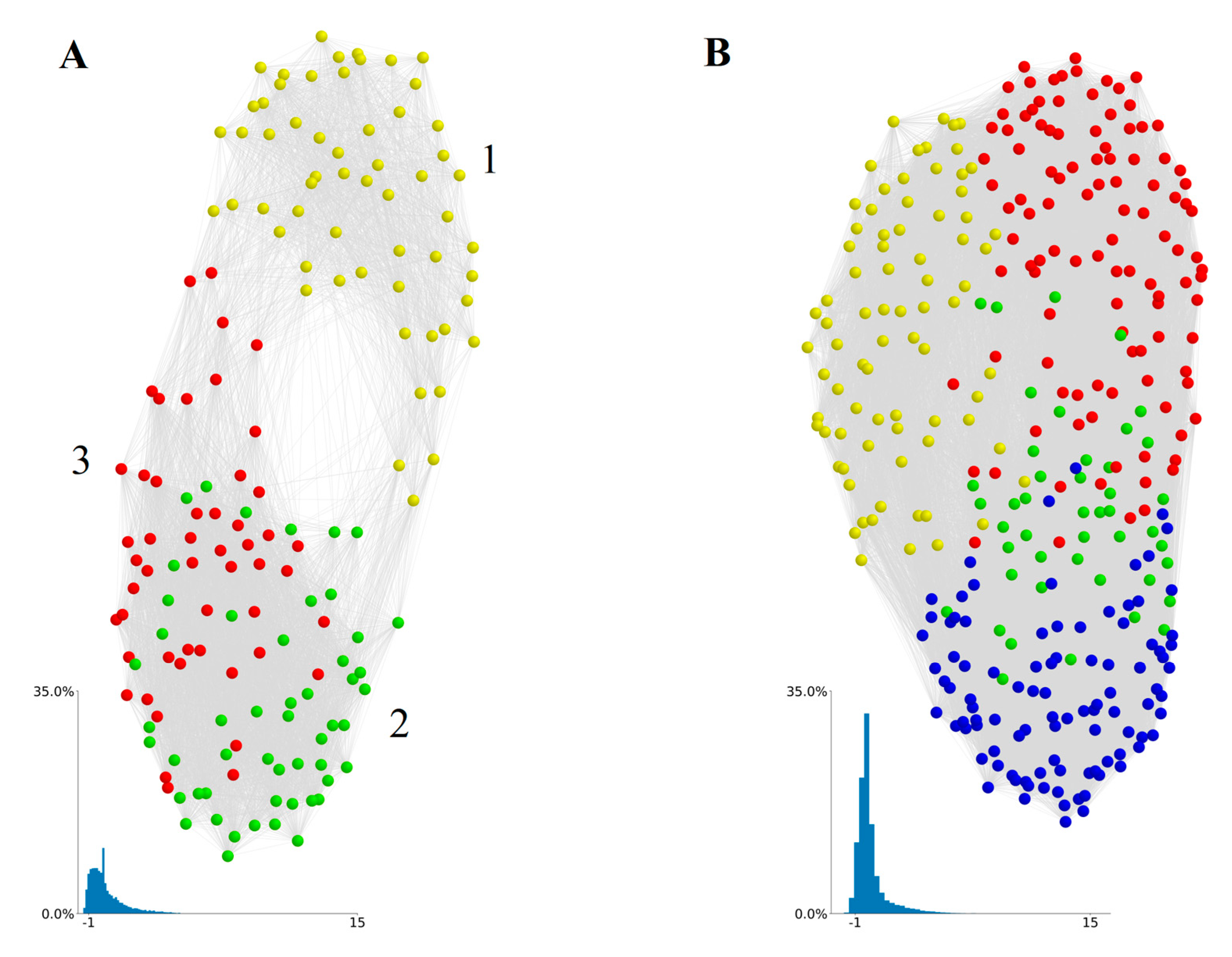
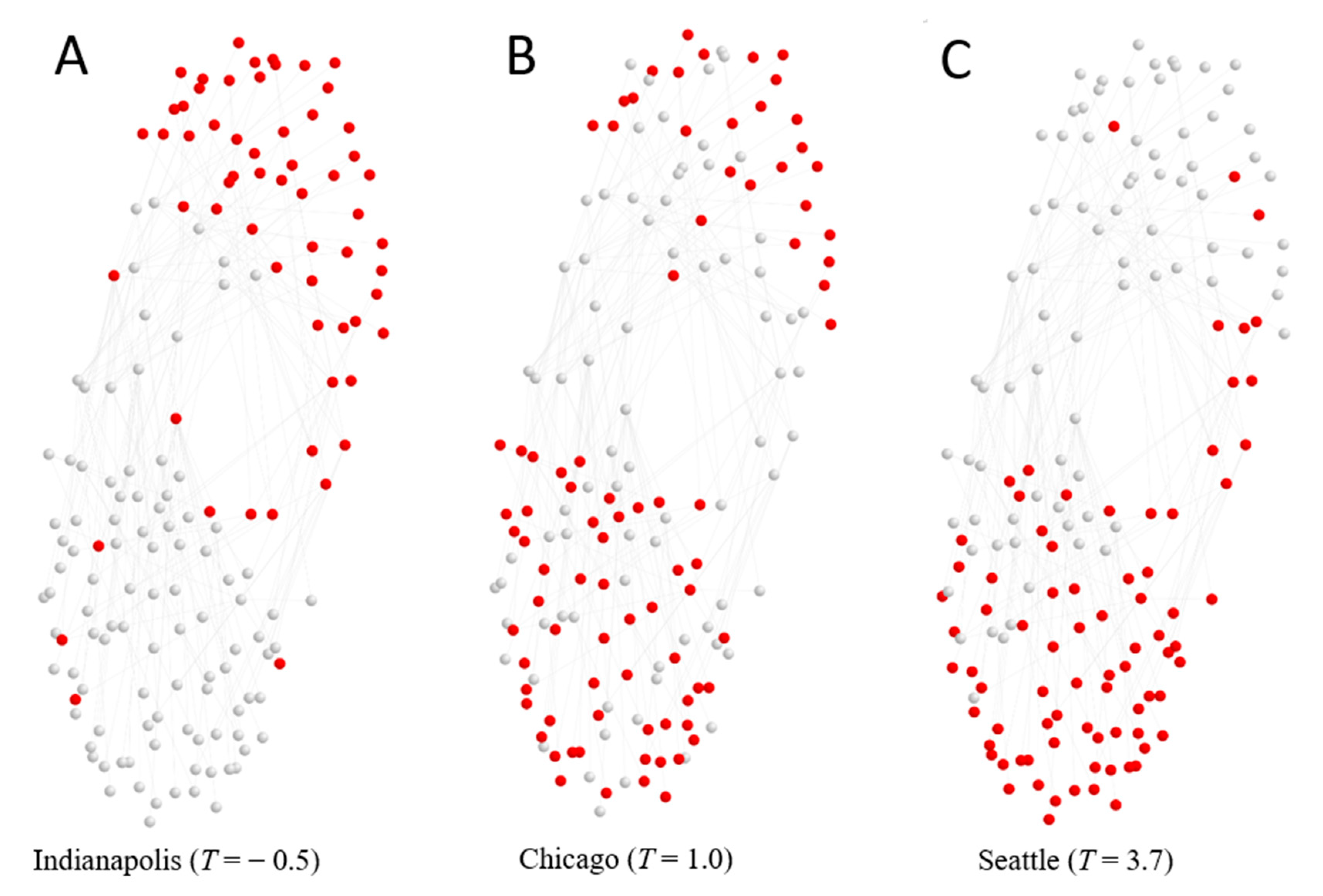
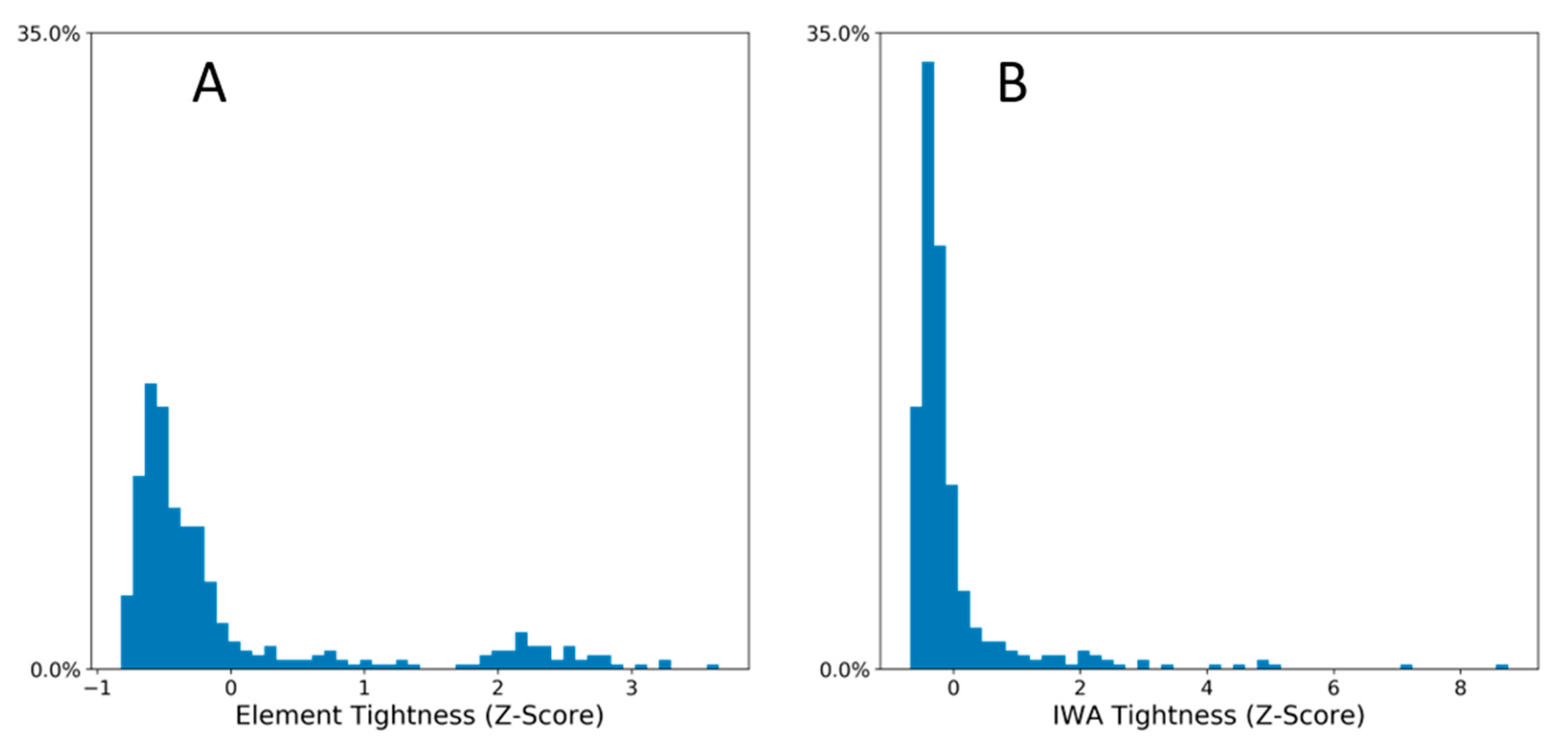
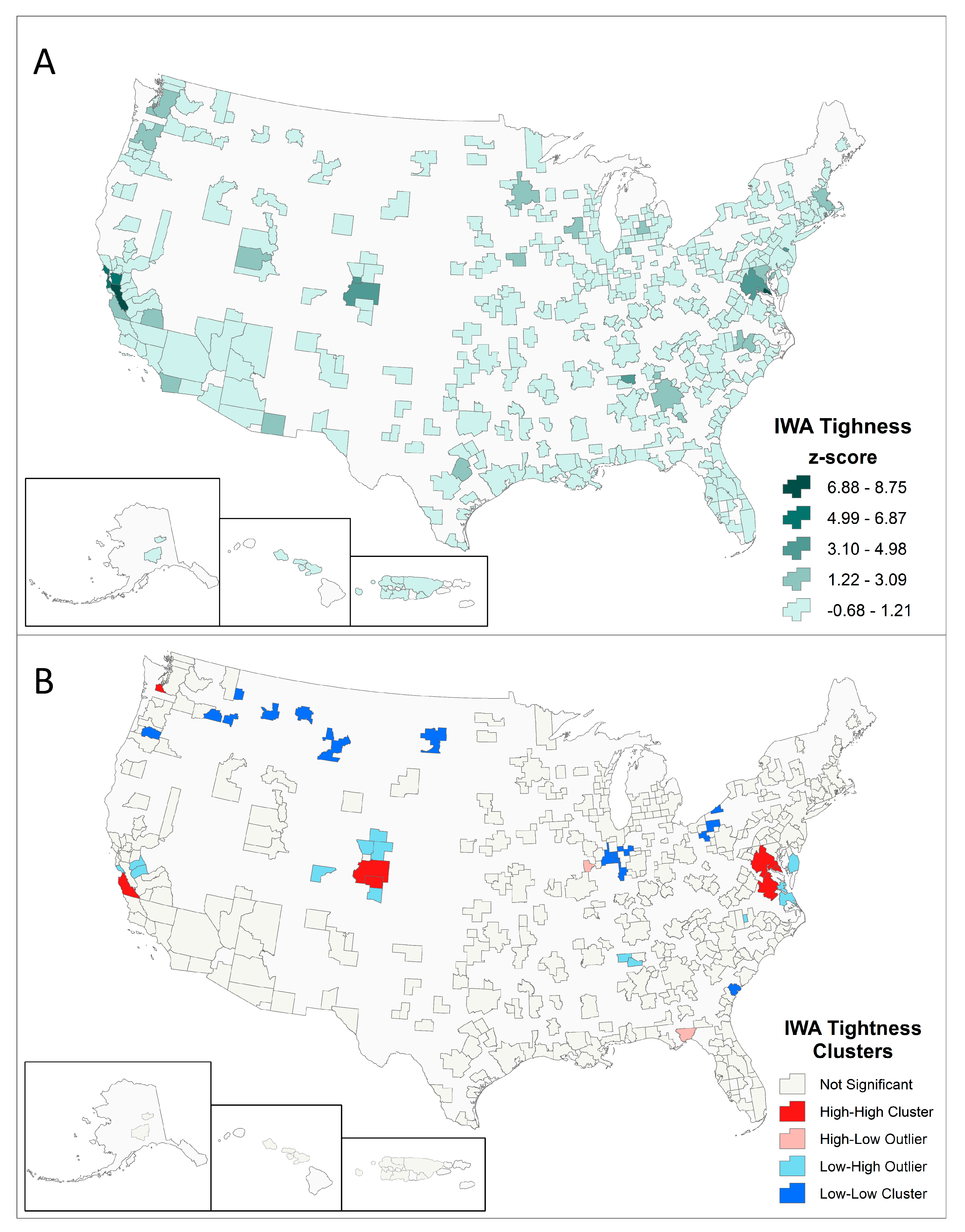
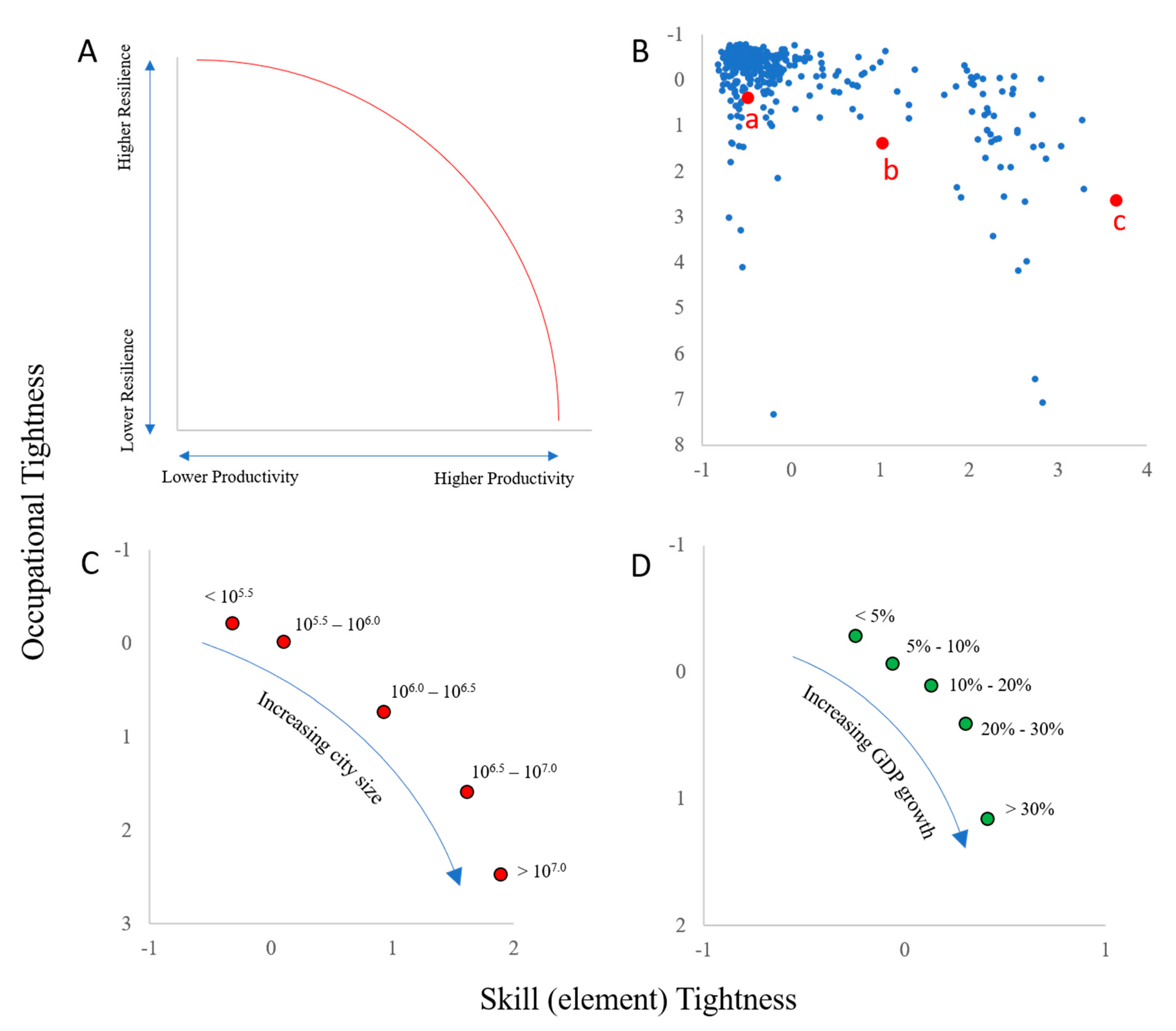
| Rank | i | j | xi,j |
|---|---|---|---|
| 1 | Study details of artistic productions | Present arts or entertainment performances | 15.5 |
| 2 | Study details of artistic productions | Alter audio or video recordings | 13.1 |
| 3 | Alter audio or video recordings | Present arts or entertainment performances | 11.7 |
| 4 | Consult legal materials or public records | Discuss legal matters with clients, disputants, or legal professionals or staff | 9.9 |
| 5 | Study details of artistic productions | Develop news, entertainment, or artistic content | 9.8 |
| 55,108 | Plan events or programs | Hunt animals | −1.6 |
| 55,109 | Clean tools, equipment, facilities, or work areas | Direct scientific or technical activities | −1.7 |
| 55,110 | Analyze scientific or applied data using mathematical principles | Clean tools, equipment, facilities, or work areas | −1.7 |
| 55,111 | Hunt animals | Prepare proposals or grant applications | −1.8 |
| 55,112 | Evaluate scholarly work | Hunt animals | −1.8 |
| Rank | Metropolitan Statistical Area (MSA) | T * |
|---|---|---|
| 1 | San Jose–Sunnyvale–Santa Clara, CA (41,940) | 8.75 |
| 2 | California–Lexington Park, MD (15,680) | 7.05 |
| 3 | San Francisco–Oakland–Berkeley, CA (41,860) | 5.09 |
| 4 | Boulder, CO (14,500) | 4.89 |
| 5 | Huntsville, AL (26,620) | 4.84 |
| 391 | Kennewick–Richland, WA (28,420) | −0.65 |
| 392 | Montgomery, AL (33,860) | −0.65 |
| 393 | New Bern, NC (35,100) | −0.65 |
| 394 | Bellingham, WA (13,380) | −0.66 |
| 395 | Knoxville, TN (28,940) | −0.68 |
© 2020 by the authors. Licensee MDPI, Basel, Switzerland. This article is an open access article distributed under the terms and conditions of the Creative Commons Attribution (CC BY) license (http://creativecommons.org/licenses/by/4.0/).
Share and Cite
Shutters, S.T.; Waters, K. Inferring Networks of Interdependent Labor Skills to Illuminate Urban Economic Structure. Entropy 2020, 22, 1078. https://doi.org/10.3390/e22101078
Shutters ST, Waters K. Inferring Networks of Interdependent Labor Skills to Illuminate Urban Economic Structure. Entropy. 2020; 22(10):1078. https://doi.org/10.3390/e22101078
Chicago/Turabian StyleShutters, Shade T., and Keith Waters. 2020. "Inferring Networks of Interdependent Labor Skills to Illuminate Urban Economic Structure" Entropy 22, no. 10: 1078. https://doi.org/10.3390/e22101078
APA StyleShutters, S. T., & Waters, K. (2020). Inferring Networks of Interdependent Labor Skills to Illuminate Urban Economic Structure. Entropy, 22(10), 1078. https://doi.org/10.3390/e22101078






